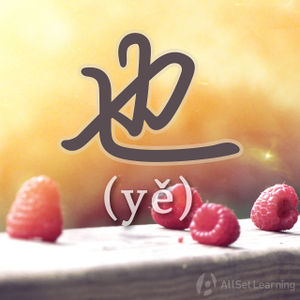Difference between revisions of "The "also" adverb "ye""
| Line 5: | Line 5: | ||
== Structure with Predicate Verbs== | == Structure with Predicate Verbs== | ||
| − | Since it is an adverb, "也" is inserted after the subject, before the verb or auxiliary verb: | + | Since it is an [[adverb]], "也" is inserted after the subject, before the [[verb]] or [[auxiliary verb]]: |
<div class="jiegou"> | <div class="jiegou"> | ||
| Line 12: | Line 12: | ||
</div> | </div> | ||
| + | |||
| + | Please note that in English, we replace the word "too" with "either" in negative sentences. For example: | ||
| + | |||
| + | * A: I like cats.<br />B: I like cats '''too'''. | ||
| + | * A: I don't like cats.<br />B: I don't like cats '''either'''. | ||
== Examples == | == Examples == | ||
| Line 17: | Line 22: | ||
<div class="liju"> | <div class="liju"> | ||
| − | * 我 | + | * 我 <em>也</em> 喜欢。<span class="trans">I like it too. / I also like it.</span> |
| − | * 你 是 北京 人?我 <em>也</em> 是。<span class="trans"> | + | * 你 是 北京 人?我 <em>也</em> 是。<span class="trans">Are you a Beijinger? I am too.</span> |
| − | * 我 <em>也</em> 在 学 中文。<span class="trans"> | + | * 我 <em>也</em> 在 学 中文。<span class="trans">I am also studying Chinese.</span> |
| − | * 他 <em>也</em> 不 知道 这 是 什么。<span class="trans"> | + | * 他 <em>也</em> 不 知道 这 是 什么。<span class="trans">I don't know what this is either.</span> |
* 我 <em>也</em> 有 一个 儿子。 <span class="trans">NEED TRANSLATION</span> | * 我 <em>也</em> 有 一个 儿子。 <span class="trans">NEED TRANSLATION</span> | ||
* 他们 <em>也</em> 是 法国人。<span class="trans">They are also French.</span> | * 他们 <em>也</em> 是 法国人。<span class="trans">They are also French.</span> | ||
Revision as of 06:53, 8 September 2013
-
Level
-
Similar to
-
Used for
-
Keywords
The English adverb "too" or "also" is expressed in Chinese as 也 (yě).
Contents
Structure with Predicate Verbs
Since it is an adverb, "也" is inserted after the subject, before the verb or auxiliary verb:
Subject + 也 + [Verb Phrase]
Please note that in English, we replace the word "too" with "either" in negative sentences. For example:
- A: I like cats.
B: I like cats too. - A: I don't like cats.
B: I don't like cats either.
Examples
- 我 也 喜欢。I like it too. / I also like it.
- 你 是 北京 人?我 也 是。Are you a Beijinger? I am too.
- 我 也 在 学 中文。I am also studying Chinese.
- 他 也 不 知道 这 是 什么。I don't know what this is either.
- 我 也 有 一个 儿子。 NEED TRANSLATION
- 他们 也 是 法国人。They are also French.
- 我 知道 你 也 想 去 旅游。NEED TRANSLATION
- 我 也 喜欢 吃 水饺。I also like to eat boiled dumplings.
- 你 也 喜欢 喝 啤酒 吗?Do you like to drink beer, too?
- 你 也 会 来 我 家 吗?NEED TRANSLATION
- 你 也 觉得 这 个 餐厅 不 好?NEED TRANSLATION
Structure with Adjectives
也 can also be used with adjectives. 你知道在汉语中如果是形容词直接做谓语,那么这个形容词前面一般要用一个副词修饰,尤其是单音节形容词。所以在这里,形容词前面要加一个副词,比如"很""比较""挺""非常"。如果不是特别强调,一般人会忽略"很"所包含的very的意思,只用于补足音节、修饰句子。
Subject + 也 + Adverb + Adjective
Examples
- 你 也 很 高。You are also tall.
- 他 也 很 胖。He is also fat.
- 昨天 很 冷,今天 也 很 冷。NEED TRANSLATION
- 这 种 酒 也 很 好 喝。NEED TRANSLATION
- 他 生气 了?我 也 很 生气!NEED TRANSLATION
- 这 个 问题 也 比较 麻烦。NEED TRANSLATION
- 我 觉得 这 个 餐厅 也 比较 好。NEED TRANSLATION
- 明天 的 工作 也 挺 多。NEED TRANSLATION
- 我 也 有点儿 累。NEED TRANSLATION
- 我 也 非常 累。NEED TRANSLATION
- 我 知道 这 个 人 也 非常 有 钱。NEED TRANSLATION
"Me too"
It can be tricky to know how to say "me too" when you first study 也, as you can't say "我也......" - this is not a complete sentence. The correct way is:
- 我 也 是。
你还可以把上句中的主语换成其他主语,比如"他""我们""我们公司""我的太太"。表示这个主语具有上文中提到的事物的性质。
- 他 也 是。
- 我们 也 是。
- 我 太太 也 是。
- 我们 公司 也 是。
- 中国 人 也 是。
- 巧克力 也 是。
- 冰 的 可乐 好喝,咖啡 也 是。



